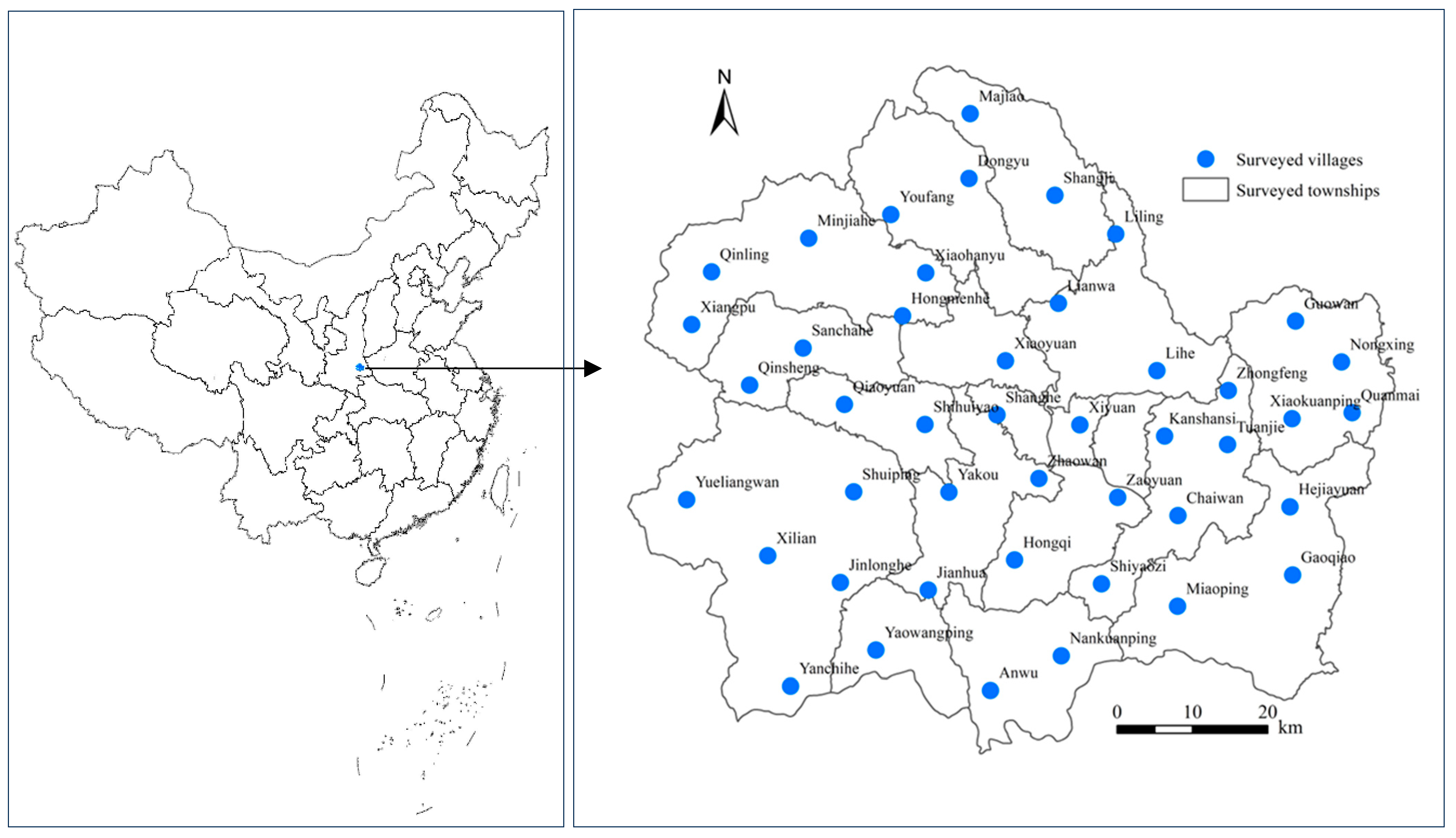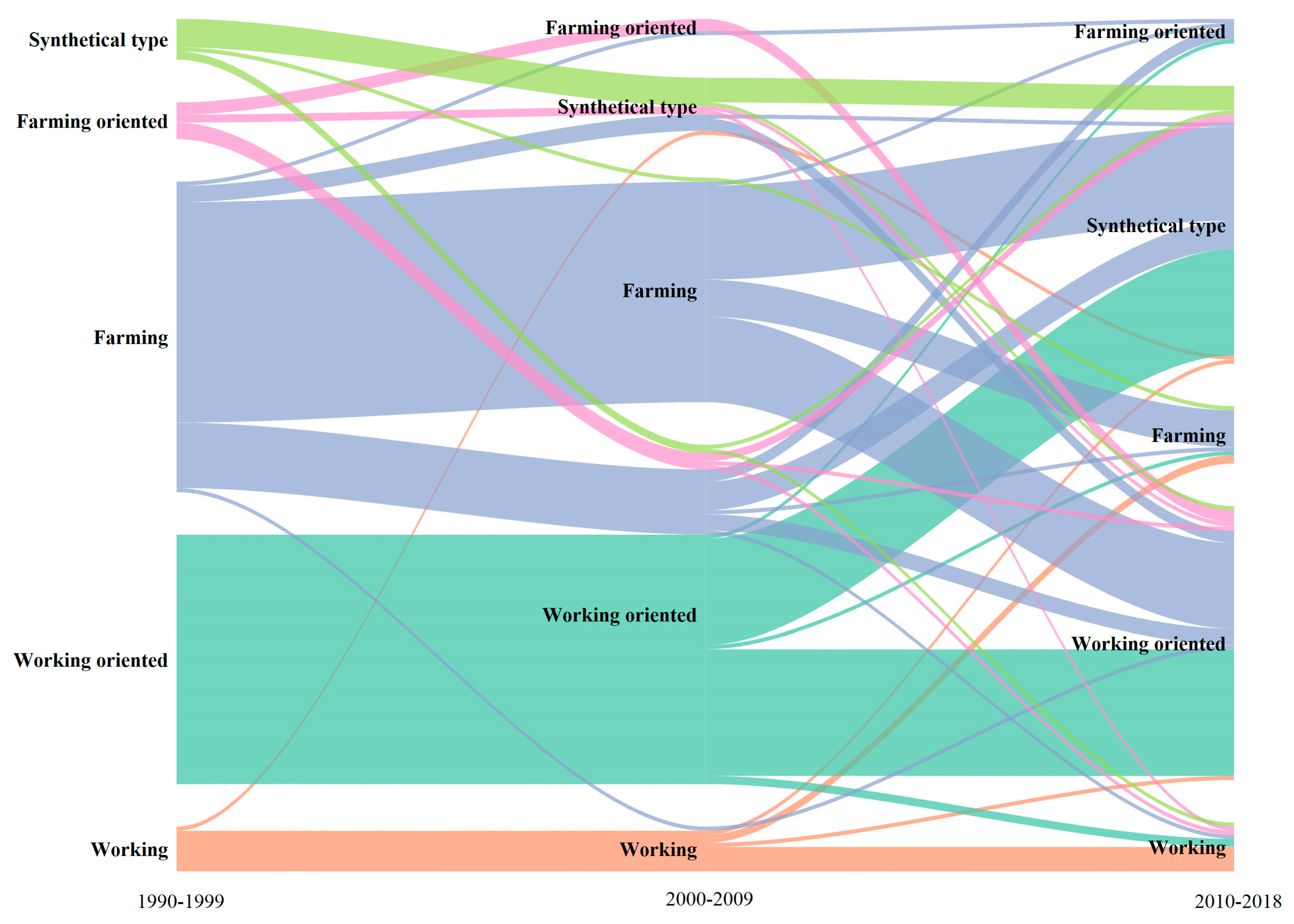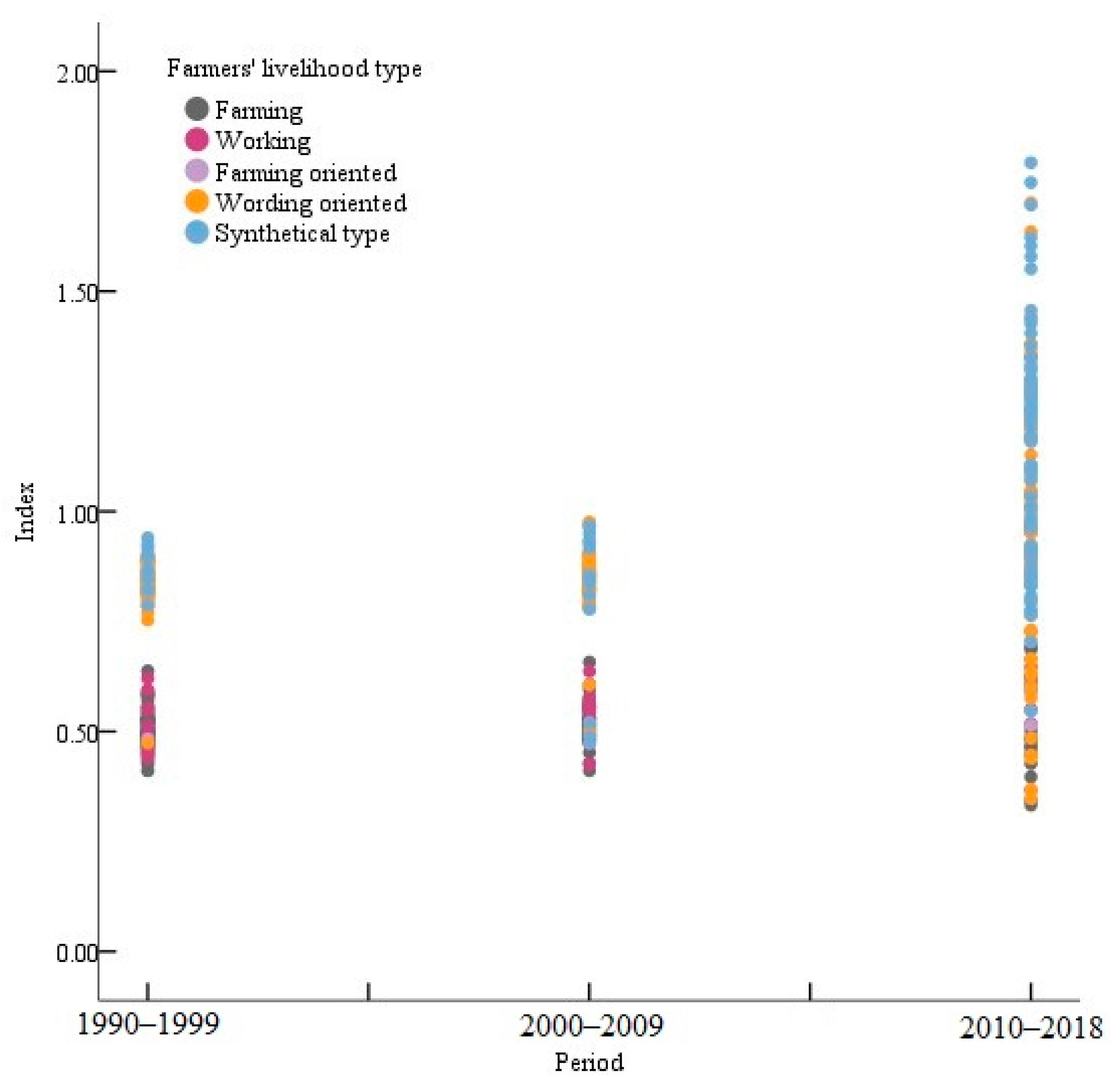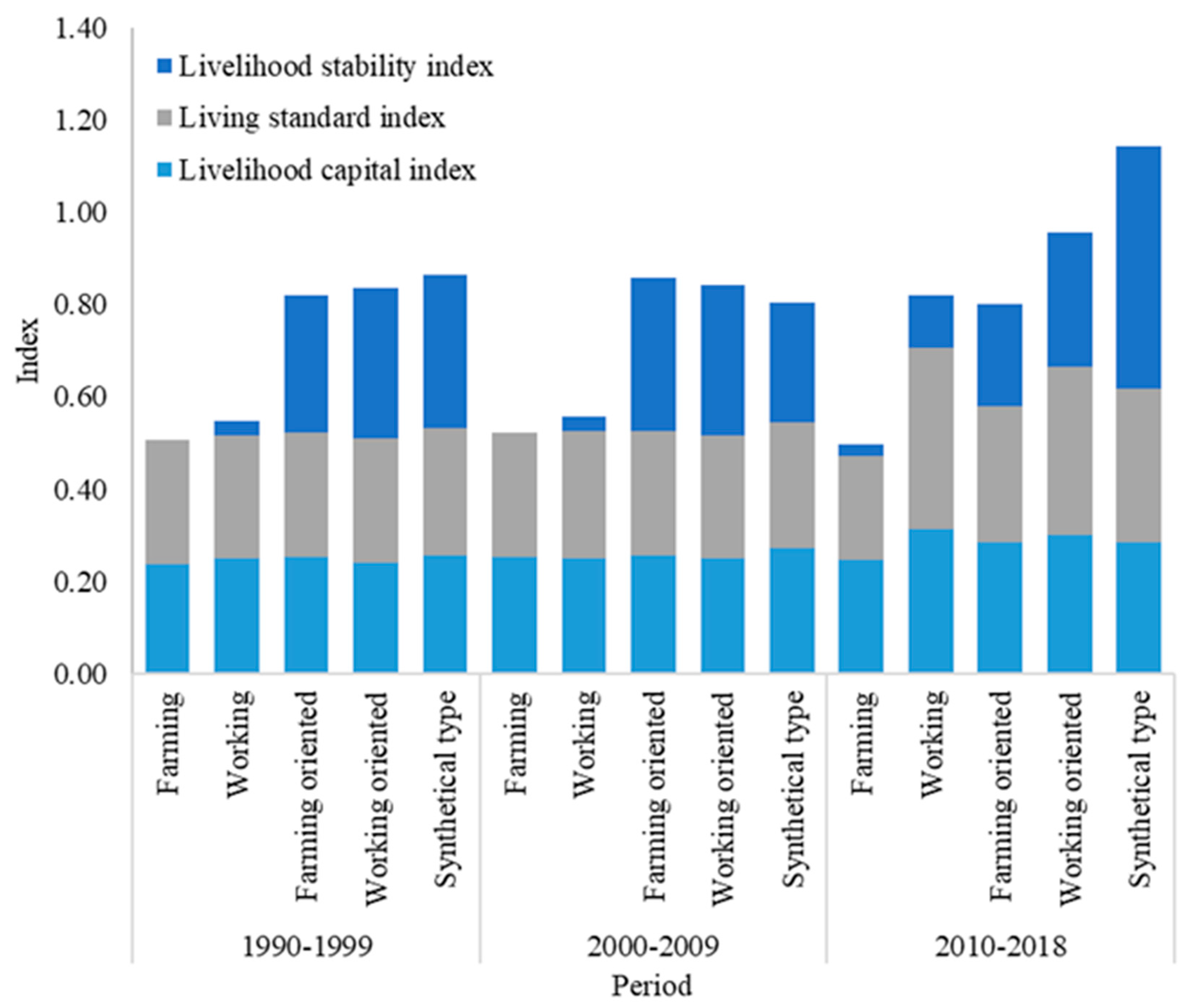Response and Adaptation of Farmers’ Livelihood Transformation under the Background of Rural Transformation: Evidence from the Qinling Mountains, China
Abstract
:1. Introduction
2. Materials and Methods
2.1. Study Area
2.2. Data Collection
2.3. Indicators and Quantitative Analysis
2.3.1. Evaluation System of Livelihood Transformation Adaptation
2.3.2. Quantitative Analysis Methods
- (1)
- Due to the use of logarithmic operations in the entropy method, standardized values cannot be directly calculated. To address the impact of negative or zero numbers on operations, the standardized numerical translation processing is
- (2)
- Quantify each indicator equally and calculate the proportion of the i-th sample to the j-th indicator:
- (3)
- Calculate the entropy of indicator information:
- (4)
- Calculate the coefficient of difference for indicators:
- (5)
- Normalize the difference coefficient and calculate the indicator weight:
3. Results and Discussion
3.1. Rural Transformation and Farmers’ Livelihood Response
- (1)
- Traditional agricultural planting: 1990–1999
- (2)
- Restricted agricultural development: 2000–2009
- (3)
- Agricultural development transformation: 2010–2018
3.2. Adaptation of Farmers’ Livelihood Transformation
3.3. Analysis of Influencing Factors
3.3.1. Influencing Factors of the Type of Farmers’ Livelihood Transformation
3.3.2. Obstacle Factors to the Adaptation of Farmers’ Livelihood Transformation
3.4. Policy Implications
4. Conclusions
Author Contributions
Funding
Institutional Review Board Statement
Informed Consent Statement
Data Availability Statement
Conflicts of Interest
References
- He, Y.; Hu, Y.; Song, J.; Jing, X. Variation of runoff between southern and northern China and their attribution in the Qinling Mountains, China. Ecol. Eng. 2021, 171, 106374. [Google Scholar] [CrossRef]
- Zhang, H.; Guo, Y.; Gao, B. Multi-model Suitability Assessment of Construction Land in Tsinling Mountains Based on the Niche Theory: A Case Study of Shangzhou, Shangluo. Geogr. Geo-Inf. Sci. 2016, 32, 83–89. (In Chinese) [Google Scholar]
- Ma, C.; Wang, X.; Yuan, X.; Xu, H.; Ren, Z.; Wei, X. The evolution of social space in mountainous rural areas: A case study of three counties in Qinling Mountains area, Shaanxi. J. Nat. Resour. 2021, 36, 2557–2570. (In Chinese) [Google Scholar] [CrossRef]
- Kates, R.W.; Clark, W.C.; Corell, R.; Hall, J.M.; Jaeger, C.C.; Lowe, L.; McCarthy, J.J.; Schellnhuber, H.J.; Bolin, B.; Dickson, N.M.; et al. Environment and development: Sustainability science. Science 2001, 292, 641–642. [Google Scholar] [CrossRef] [PubMed]
- Below, T.B.; Mutabazi, K.D.; Kirschke, D.; Franke, C.; Sieber, S.; Siebert, R.; Tscherning, K. Can farmers’ adaptation to climate change be explained by socio-economic household-level variables. Glob. Environ. Chang. 2012, 22, 223–235. [Google Scholar] [CrossRef]
- Chen, J.; Yin, S.; Gebhardt, H.; Yang, X. Farmers’ livelihood adaptation to environmental change in an arid region: A case study of the Minqin Oasis, northwestern China. Ecol. Indic. 2018, 93, 411–423. [Google Scholar] [CrossRef]
- Dovie, D.B.K.; Pabi, O. Partial climatic risk screening, adaptation and livelihoods in a coastal urban area in Ghana. Habitat Int. 2023, 138, 102868. [Google Scholar] [CrossRef]
- Wichern, J.; Descheemaeker, K.; Giller, K.E.; Ebanyat, P.; Taulya, G.; Wijk, M.T. Vulnerability and adaptation options to climate change for rural livelihoods—A country-wide analysis for Uganda. Agric. Syst. 2019, 176, 102663. [Google Scholar] [CrossRef]
- Kuang, F.; Jin, J.; He, R.; Wan, X.; Ning, J. Influence of livelihood capital on adaptation strategies: Evidence from rural households in Wushen Banner, China. Land Use Policy 2019, 89, 104228. [Google Scholar] [CrossRef]
- Ankrah, D.A.; Anum, R.; Anaglo, J.N.; Boateng, S.D. Influence of sustainable livelihood capital on climate variability adaptation strategies. Environ. Sustain. Indic. 2023, 18, 100233. [Google Scholar] [CrossRef]
- Kuang, F.; Jin, J.; He, R.; Ning, J.; Wan, X. Farmers’ livelihood risks, livelihood assets and adaptation strategies in Rugao City, China. J. Environ. Manag. 2020, 264, 110463. [Google Scholar] [CrossRef] [PubMed]
- Zeng, X.; Guo, S.; Deng, X.; Zhou, W.; Xu, D. Livelihood risk and adaptation strategies of farmers in earthquake hazard threatened areas: Evidence from Sichuan province, China. Int. J. Disaster Risk Reduct. 2020, 53, 101971. [Google Scholar] [CrossRef]
- Mihiretu, A.; Okoyo, E.N.; Lemma, T. Climate variability trends-community perspective-livelihood adaptation strategy nexus in the arid-tropics, Ethiopia. J. Arid. Environ. 2023, 210, 104929. [Google Scholar] [CrossRef]
- Ichinose, Y.; Higuchi, H.; Kubo, R.; Nishigaki, T.; Kilasara, M.; Shinjo, H.; Funakawa, S. Adaptation of farmland management strategies to maintain livelihood by the Chagga people in the Kilimanjaro highlands. Agric. Syst. 2020, 181, 102829. [Google Scholar] [CrossRef]
- Williams, L.J.; Wensveen, M.; Dahlanuddin; Grünbühel, C.M.; Puspadi, K. Adoption as adaptation: Household decision making and changing rural livelihoods in Lombok, Indonesia. J. Rural. Stud. 2022, 89, 328–336. [Google Scholar] [CrossRef]
- Makwinja, R.; Kaunda, E.; Mengistou, S.; Alemiew, T.; Njaya, F.; Kosamu, I.B.M.; Kaonga, C.C. Lake Malombe fishing communities’ livelihood, vulnerability, and adaptation strategies. Curr. Res. Environ. Sustain. 2021, 3, 100055. [Google Scholar] [CrossRef]
- Kulsum, U.; Timmermans, J.; Haasnoot, M.; Khan, M.S.A.; Thissen, W. Why uncertainty in community livelihood adaptation is important for adaptive delta management: A case study in polders of Southwest Bangladesh. Environ. Sci. Policy 2021, 119, 54–65. [Google Scholar] [CrossRef]
- Fang, Y.P.; Zhu, R.; Zhang, C.J.; Rasul, G.; Neupane, N. Cascading Adaptation of Rural Livelihood to Changing Environment: Conceptual Framework and Experiment from the Koshi River Basin. Adv. Clim. Chang. Res. 2020, 11, 141–157. [Google Scholar] [CrossRef]
- Pandey, V.P.; Babel, M.S.; Shrestha, S.; Kazama, F. A framework to assess adaptive capacity of the water resources system in Nepalese River basins. Ecol. Indic. 2011, 11, 480–488. [Google Scholar] [CrossRef]
- Villiers, A.C.; Esler, K.J.; Knight, A.T. Social processes promoting the adaptive capacity of rangeland managers to achieve resilience in the Karoo, South Africa. J. Environ. Manag. 2014, 146, 276–283. [Google Scholar] [CrossRef]
- Thathsarani, U.S.; Gunaratne, L.H.P. Constructing and Index to Measure the Adaptive Capacity to Climate Change in Sri Lanka. Procedia Eng. 2018, 212, 278–285. [Google Scholar] [CrossRef]
- Murthy, C.S.; Laxman, B.; Sai, M.V.R.S. Geospatial analysis of agricultural drought vulnerability using a composite index based on exposure, sensitivity and adaptive capacity. Int. J. Disaster Risk Reduct. 2015, 12, 163–171. [Google Scholar] [CrossRef]
- Yin, S.; Yang, X.; Chen, J. Progress of research on adaptation of human-environment systems: Concepts, theoretical frameworks, and methods. Prog. Geogr. 2021, 40, 330–342. (In Chinese) [Google Scholar] [CrossRef]
- Acosta, L.; Klein, R.J.; Reidsma, P.; Metzger, M.J.; Rounsevell, M.D.; Leemans, R.; Schröter, D. A spatially explicit scenario-driven model of adaptive capacity to global change in Europe. Glob. Environ. Chang. 2013, 23, 1211–1224. [Google Scholar] [CrossRef]
- Clarvis, M.H.; Allan, A. Adaptive capacity in a Chilean context: A questionable model for Latin America. Environ. Sci. Policy 2014, 43, 78–90. [Google Scholar] [CrossRef]
- Long, H.; Zou, J.; Pykett, J.; Li, Y. Analysis of rural transformation development in China since the turn of the new millennium. Appl. Geogr. 2011, 31, 1094–1105. [Google Scholar] [CrossRef]
- Mitchell, C.J.A. Creative destruction or creative enhancement? Understanding the transformation of rural spaces. J. Rural. Stud. 2013, 32, 375–387. [Google Scholar] [CrossRef]
- Wang, Y.; Liu, Y.; Li, Y. The spatio-temporal patterns of urban–rural development transformation in China since 1990. Habitat Int. 2016, 53, 178–187. [Google Scholar] [CrossRef]
- Parsons, M.; Nalau, J. Historical analogies as tools in understanding transformation. Glob. Environ. Chang. 2016, 38, 82–96. [Google Scholar] [CrossRef]
- Liu, J.; Liu, Y.; Yan, M. Spatial and temporal change in urban-rural land use transformation at village scale: A case study of Xuanhua district, North China. J. Rural. Stud. 2016, 47, 425–434. [Google Scholar] [CrossRef]
- Gibson, K.; Cahill, A.; Mckay, D. Rethinking the dynamics of rural transformation: Performing different development pathways in a Philippine municipality. Trans. Inst. Br. Geogr. 2010, 35, 237–255. [Google Scholar] [CrossRef]
- Tang, Q.; Bennett, S.J.; Xu, Y.; Li, Y. Agricultural practices and sustainable livelihoods: Rural transformation within the Loess Plateau, China. Appl. Geogr. 2013, 41, 15–23. [Google Scholar] [CrossRef]
- Wang, D.; Wang, X.; Hao, H.; Lin, D.; Xiao, R. Research progress on farmers’ livelihood transformation and its ecological effects—A review. J. Resour. Ecol. 2022, 13, 912–924. [Google Scholar]
- Korah, P.I.; Nunbogu, A.M.; Akanbang, B.A.A. Spatio-temporal dynamics and livelihoods transformation in Wa, Ghana. Land Use Policy 2018, 77, 174–185. [Google Scholar] [CrossRef]
- Chen, K.; Wang, Y.; Li, N.; Xu, Y.; Zheng, Y.; Zhan, X.; Li, Q. The impact of farmland use transition on rural livelihood transformation in China. Habitat Int. 2023, 135, 102784. [Google Scholar] [CrossRef]
- Diao, X.; Magalhaes, E.; Silver, J. Cities and rural transformation: A spatial analysis of rural livelihoods in Ghana. World Dev. 2019, 121, 141–157. [Google Scholar] [CrossRef]
- Cely-Santos, M.; Hernández-Manrique, O.L. Fighting change: Interactive pressures, gender, and livelihood transformations in a contested region of the Colombian Caribbean. Geoforum 2021, 125, 9–24. [Google Scholar] [CrossRef]
- Jiang, X.; Yin, G.; Lou, Y.; Xie, S.; Wei, W. The Impact of Transformation of Farmers’ Livelihood on the Increasing Labor Costs of Grain Plantation in China. Sustainability 2021, 13, 11637. [Google Scholar] [CrossRef]
- Escarcha, J.F.; Lassa, J.A.; Palacpac, E.P.; Zander, K.K. Livelihoods transformation and climate change adaptation: The case of smallholder water buffalo farmers in the Philippines. Environ. Dev. 2020, 33, 100468. [Google Scholar] [CrossRef]
- Schumpeter, P. Capitalism, Socialism and Democracy; Harper and Row: New York, NY, USA, 1950. [Google Scholar]
- Yin, S. Adaptation of rural areas under drought stress: Based on a survey of peasant household in the Minqin Oasis. Master’s Thesis, Northwest University, Xi’an, China, 2017. (In Chinese). [Google Scholar]
- Tohidimoghadam, A.; PourSaeed, A.; Bijani, M.; Samani, R.E. Towards farmers’ livelihood resilience to climate change in Iran: A systematic review. Environ. Sustain. Indic. 2023, 19, 100266. [Google Scholar] [CrossRef]
- Li, L.; Jin, J.; Zhang, C.; Qiu, X.; Liu, D. How do livelihood capital affect farmers’ energy-saving behaviors: Evidence from China. J. Clean. Prod. 2023, 414, 137769. [Google Scholar] [CrossRef]
- Yang, Y.; Yuan, X.; Ma, C.; Xu, H.; Ren, Z. Coupling coordination analysis of farmers′ livelihoods and rural development in the Qinling-Daba Mountains: A case study of Luonan County in Shaanxi Province. J. Ecol. Rural. Environ. 2021, 37, 448–455. (In Chinese) [Google Scholar]
- Xu, J.; Li, G.; Wang, Y. Review and prospect of resource-based city vulnerability in China and Abroad. Resour. Sci. 2015, 37, 1266–1278. (In Chinese) [Google Scholar]
- Zhu, L.; Mei, X.; Xiao, Z. The digital economy promotes rural revitalization: An empirical analysis of Xinjiang in China. Sustainability 2023, 15, 12278. [Google Scholar] [CrossRef]
- Wang, D.; Li, Y.; Zhang, Z.; Gao, S.; Zhou, Q.; Zhuo, Y.; Wen, X.; Guo, Z. Evaluating urban ecological civilization and its obstacle factors based on integrated model of PSR-EVW-TOPSIS: A case study of 13 cities in Jiangsu Province, China. Ecol. Indic. 2021, 133, 108431. [Google Scholar] [CrossRef]
- Wang, D.; Shen, Y.; Zhao, Y.; He, W.; Liu, X.; Qian, X.; Lv, T. Integrated assessment and obstacle factor diagnosis of China’s scientific coal production capacity based on the PSR sustainability framework. Resour. Policy 2020, 68, 101794. [Google Scholar] [CrossRef]
- Yin, S.; Chen, J.; Wu, K.; Yang, X. Adaptation of farming households under drought stress: Based on a survey in the Minqin Oasis. Prog. Geogr. 2016, 35, 644–654. (In Chinese) [Google Scholar]
- Yin, S.; Chen, J.; Yang, X. Adaptive behavior of farming household and influential mechanism in the background of social-ecological system reconstruction. Hum. Geogr. 2020, 35, 112–121. (In Chinese) [Google Scholar]
- Wang, K.; Sun, P.; Wang, X.; Mo, J.; Li, N.; Zhang, J. Impact of the Grain for Green Project on the well-being of farmer households: A case study of the mountainous areas of Northern Hebei Province, China. Land 2023, 12, 1257. [Google Scholar] [CrossRef]
- Duan, T.; Li, Y.; Wang, R.; Ren, L. Research on the ability to eliminate poverty from the rural female-headed households in poor mountainous areas in the perspective of precision poverty alleviation: Survey data based on farmers’ families in the Qinba Mountain area of Southern Shaanxi. J. Shaanxi Norm. Univ. (Philos. Soc. Sci. Ed.) 2020, 49, 40–53. (In Chinese) [Google Scholar]




| Index | Dimension | Indicator | Indicator Description and Definition | Mean Value | Standard Deviation | Weight | Anticipated Impact |
|---|---|---|---|---|---|---|---|
| Livelihood capital | Natural capital | Ecological governance area | Per capita area of Grain for Green | 0.092 | 0.283 | 0.060 | - |
| Actual cultivated area | Per capita actual cultivated area of households | 0.698 | 0.718 | 0.073 | + | ||
| Physical capital | Housing area | Per capita housing area of households | 28.100 | 22.368 | 0.071 | + | |
| Household physical assets | Number of daily durable consumer goods | 2.639 | 1.644 | 0.068 | + | ||
| Livestock | Number of livestock = cattle × 1.4 + donkey × 1.2 + sheep × 1 + pig × 0.8 + chicken × 0.6 | 7.689 | 77.640 | 0.102 | + | ||
| Financial capital | Income status | The proportion of total household cash income (including government subsidies) to the total family population | 4867.730 | 7703.490 | 0.091 | + | |
| The gap between the rich and the poor | Farmers′ perception of the degree of wealth gap within the village. 0 = none, 0.25 = very little, 0.5 = ordinary, 0.75 = much more, 1 = quite a lot | 0.551 | 0.288 | 0.067 | + | ||
| Human capital | Household workforce | The proportion of the number of family workers (aged 16–65) to the total population | 0.551 | 0.267 | 0.065 | + | |
| Health status | Proportion of the number of disabled people to the total family population | 0.258 | 0.296 | 0.065 | - | ||
| Policy awareness | The degree of understanding of government policies and measures such as ecological governance and agricultural structural adjustment. 0 = none, 0.25 = very little, 0.5 = ordinary, 0.75 = much more, 1 = quite a lot | 0.431 | 0.241 | 0.067 | + | ||
| Social capital | Social network | Number of households receiving assistance | 10.894 | 11.378 | 0.075 | + | |
| Leadership potential | Number of village committee members in the family | 0.124 | 0.465 | 0.127 | + | ||
| Assistance opportunities | Number of borrowers and credit opportunities. Credit opportunities: 0 = no, 1 = yes | 4.022 | 2.628 | 0.070 | + |
| Type | Description | 1990–1999 | 2000–2009 | 2010–2018 | |||
|---|---|---|---|---|---|---|---|
| Number | Proportion | Number | Proportion | Number | Proportion | ||
| Farming | Choosing only farming as a means of livelihood | 76 | 45.5% | 55 | 32.9% | 14 | 8.4% |
| Working | Choosing only working as a means of livelihood | 11 | 6.6% | 11 | 6.6% | 12 | 7.2% |
| Farming oriented | Choosing farming and working as livelihoods with more than 50% of income from farming | 9 | 5.4% | 4 | 2.4% | 6 | 3.6% |
| Working oriented | Choosing farming and working as livelihoods with more than 50% of income from working | 61 | 36.5% | 83 | 49.7% | 67 | 40.1% |
| Synthetical type | Choosing three or more livelihoods, including farming, working, and other ways. | 10 | 6.0% | 14 | 8.4% | 68 | 40.7% |
| Period | Factors | Farming | Working | Farming Oriented | Working Oriented | ||||
|---|---|---|---|---|---|---|---|---|---|
| B | Exp (B) | B | Exp (B) | B | Exp (B) | B | Exp (B) | ||
| 1990–1999 | Housing area | 2.770 | 15.953 | 24.335 ** | 3.702 × 1010 | 0.545 | 5.327 | 0.075 | 1.078 |
| Social network | −3.029 | 0.048 | −5.922 * | 0.003 | 0.326 | 0.042 | −3.963 * | 0.019 | |
| 2000–2009 | Housing area | −13.953 ** | 8.714 × 10−7 | 52.466 | 6.105 × 1022 | −69.426 | 7.059 × 10−31 | −21.459 *** | 4.792 × 10−10 |
| Income status | −40.740 *** | 2.027 × 10−18 | 236.819 | 7.068 × 10102 | −36.287 | 1.741 × 10−16 | 6.887 | 979.701 | |
| Household workforce | 7.970 ** | 2893.215 | −8.608 | 0.000 | −6.758 | 0.001 | 7.621 * | 2041.158 | |
| Assistance opportunities | 4.976 * | 144.871 | 11.723 | 123,343.408 | 15.862 ** | 7,740,669.752 | 3.720 | 41.271 | |
| Health status | −2.092 | 0.123 | −3.707 | 0.025 | −13.667 ** | 1.160 × 10−6 | −2.669 | 0.069 | |
| 2010–2018 | Housing area | 9.251 *** | 10,417.411 | 4.659 | 105.570 | −3.298 | 0.037 | −2.977 | 0.051 |
| Actual cultivated area | −0.912 | 0.402 | −55.143 *** | 1.126 × 10−24 | 4.610 | 100.448 | −0.209 | 0.811 | |
| Household physical assets | −2.198 | 0.111 | 11.263 *** | 77,870.440 | 2.759 | 15.779 | 1.046 | 2.845 | |
| Policy awareness | −0.476 | 0.621 | −5.170 ** | 0.006 | 1.452 | 4.272 | −0.884 | 0.413 | |
| Social network | 3.271 | 26.344 | −33.086 *** | 4.274 × 10−15 | 11.435 | 92,520.347 | −7.923 *** | 0.000 | |
| The gap between rich and poor | −1.344 | 0.261 | −1.128 | 0.324 | −6.598 * | 0.001 | 2.350 ** | 10.489 | |
| Period | Type | Obstacle Ranking | ||||
|---|---|---|---|---|---|---|
| 1 | 2 | 3 | 4 | 5 | ||
| 1990–1999 | Obstacle factor | Leadership potential | Livestock | Income status | Social network | Actual cultivated area |
| Obstacle degree (%) | 16.26 | 13.30 | 11.79 | 8.67 | 8.60 | |
| 2000–2009 | Obstacle factor | Leadership potential | Livestock | Income status | Social network | Actual cultivated area |
| Obstacle degree (%) | 16.50 | 13.53 | 11.68 | 8.80 | 8.76 | |
| 2010–2018 | Obstacle factor | Leadership potential | Livestock | Income status | Social network | Actual cultivated area |
| Obstacle degree (%) | 17.07 | 14.38 | 9.73 | 9.40 | 9.37 | |
Disclaimer/Publisher’s Note: The statements, opinions and data contained in all publications are solely those of the individual author(s) and contributor(s) and not of MDPI and/or the editor(s). MDPI and/or the editor(s) disclaim responsibility for any injury to people or property resulting from any ideas, methods, instructions or products referred to in the content. |
© 2023 by the authors. Licensee MDPI, Basel, Switzerland. This article is an open access article distributed under the terms and conditions of the Creative Commons Attribution (CC BY) license (https://creativecommons.org/licenses/by/4.0/).
Share and Cite
Yin, S.; Yang, X.; Chen, J. Response and Adaptation of Farmers’ Livelihood Transformation under the Background of Rural Transformation: Evidence from the Qinling Mountains, China. Sustainability 2023, 15, 13004. https://doi.org/10.3390/su151713004
Yin S, Yang X, Chen J. Response and Adaptation of Farmers’ Livelihood Transformation under the Background of Rural Transformation: Evidence from the Qinling Mountains, China. Sustainability. 2023; 15(17):13004. https://doi.org/10.3390/su151713004
Chicago/Turabian StyleYin, Sha, Xinjun Yang, and Jia Chen. 2023. "Response and Adaptation of Farmers’ Livelihood Transformation under the Background of Rural Transformation: Evidence from the Qinling Mountains, China" Sustainability 15, no. 17: 13004. https://doi.org/10.3390/su151713004
APA StyleYin, S., Yang, X., & Chen, J. (2023). Response and Adaptation of Farmers’ Livelihood Transformation under the Background of Rural Transformation: Evidence from the Qinling Mountains, China. Sustainability, 15(17), 13004. https://doi.org/10.3390/su151713004








